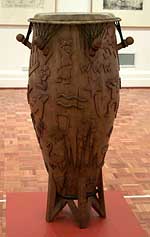Having the opportunity as a youngster to spend my summers in the forests and lakes of Northern Michigan I'm sure has affected what I'm doing right now. I remember being in the forest and playing with sticks, assembling them, and liking the feeling of being with the trees.
Wood designer-maker Marcus Tatton

I remember carving when I was about 8. I used to steal my mum's lino carving tools. I was able to go down to the workshop in the garage and carve away. I think the first thing I came up with was an acanthus leaf. I was really pleased with that.

I trained at art school in New Zealand for two years. I did a broad range of sculpture, casting, monoprints, kite-flying, life drawing. I found myself drawn to wood sculpture and I'd made furniture a little bit for my own home when I was leaving school. Very rustic furniture - I used to chainsaw mill a lot from the natural material.
I'm not very good at listening I think so I tend to take off on my own and discover things on my own. I find my work is idiosyncratic because of that but I believe that's something that for me is important. Some people can perhaps learn to listen to their own internal needs more than to other people.
The landscape is probably not a major influence in my work. I tend to work more within microclimates rather than looking at a wider landscape in order to find my inspiration. I think the landscape is less important than social context. I draw, I actually physically render a lot of ideas, but I don't think they are based on landscape as a starting point. I think they're more to do with the world of people.
I've got several ranges of tools. Every job I do seems to be of a different scale. I have four chainsaws I use if I'm doing an outside job. If I'm doing a drum I use a chainsaw but then I use flat chisels. I hardly ever use sandpaper. I tell my students – I teach a little bit of wood carving – and I tell everyone I never want to see sandpaper because I think that if you can sharpen a chisel to a very fine edge then that demonstrates ability and it can give you a much more human mark than a rounded sanded off piece that tends to look much more like a machine style job.
I think it's important to show that things have been made by humans. If there's an overabundance of machine-made things in our lives I think we lose the essence of why we are alive, so sandpaper is just one of those tools I don't agree with much. Otherwise I'll use anything!
The drums are one of the smaller things that I make with a chainsaw. I've got a large carving outside that's 5 metres long and 2 metres round. It was from a single eucalypt tree that was left wasted in the forest after the forestry had left. I worked on that piece for six or eight weeks down on site in the forest, whereas with most of the smaller objects I've been able to carry the piece out from the bush after I've thinned it out.
You wouldn't believe it but I find it quite peaceful to work with a chainsaw. Nobody can interrupt me, the telephone doesn't interrupt me, I just work away with my earmuffs on. I find that I focus really well. I find I can work for eight hours a day on a chainsaw. The technology in chainsaws now is fantastic, the anti-vibration mechanisms are very well-engineered so that you just work well. It's a very direct way of working, like drawing in three dimensions. It's a direct extension of my mind and imagination.
Email this maker: mtatton@ozemail.com.au
Related
I'm a self-taught wood turner. That didn't satisfy me in some way, there was something missing. So I toddled off to the Canberra School of Art and spent a couple of years there doing a furniture-based wood course.
I turned to furniture mid-career. I was actually trained as a musician and a high school teacher and I decided to do something else. I'd done a lot of building before and I suddenly decided to build stuff that I was going to sell instead of keep.
About fifteen years ago I bought a little house that I was going to renovate but I could never find anyone to do things exactly as I wanted them.
I was born in Melbourne and I've been in Tasmania for about 14 years. I like Tasmania because I like the bush, I like the weather, I like the timber. It's a much more natural environment than the mainland. The landscape here is inspirational to my work.
My workshop is on part of the family farm and I've lived alongside it or near it all my life apart from the occasions where I've been studying or working overseas or interstate.
I was born in Tasmania. My father was in the timber industry so I was always surrounded by stories of timber and things like that. I left school at 14 to do a trade in joinery. Prior to that I was more interested in making boats.
I came to Australia in 1970 to take up a teaching position at the Tasmanian School of Art. We were probably some of the last of the Ten Pound Poms. I was very keen after going through college in the UK to travel overseas and try other cultures.








